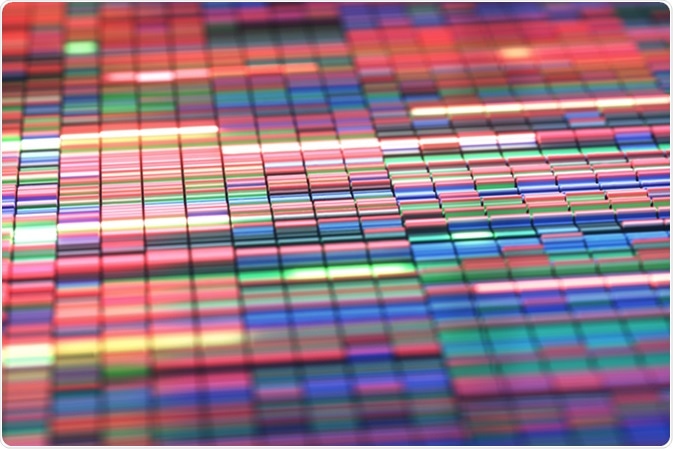For centuries the classification of living organisms into distinct groups and species was done by morphology. While this was sufficient for Darwin and early biologists to study evolution and relatedness of some organisms, this method becomes difficult when characteristics vary.
Genetic differences can instead be investigated by looking at certain sequences of ribosomal RNA (rRNA), because these sequences are conserved among organisms of the same genera and species but differ compared to other species. 16S rRNA is the sequence of rRNA commonly used to distinguish bacterial species.

Image Credit: ktsdesign / Shutterstock
History
16S rRNA sequencing for the purpose of phylogenetic studies was first employed in the 1970s. Subsequent studies helped solidify the “three domains” view of the tree of life, where Eukarya, Bacteria and Archaea are distinct domains rather than the previously held eukaryotes and prokaryotes division. Since then it has also helped clarify bacterial relationships by reclassifying and renaming some species, as well as by identification of uncultivable and unknown bacteria.
The advent of polymerase chain reaction (PCR) and sequencing facilities greatly helped analysis of 16S rRNA. Price, methodology and technology all improved, making analysis of 16S rRNA much more accessible to small laboratories and clinics for the purpose of bacterial identification. It is becoming more and more common for laboratories to only focus on small subunits (SSU) sequences rather than conducting full assays.. However, for some tasks, such as identifying a new species, using SSU sequences may not be sufficient. SSU sequences can have high similarity without being of the same species. Despite this, SSU sequences are often adequate for certain laboratory purposes.
Sequencing and the American Gut Project | Illumina MiSeq, 16S rRNA
Methods
The essence that makes the 16S rRNA sequence so valuable to phylogenetic studies is the combination of hypervariable and highly conserved regions, which alternate each other. The substitution rates for the hypervariable region are estimated to be seven thousand times that of the conserved regions. Given that the function of the 16S gene has not changed, the differences in the hypervariable regions are believed to reflect a measure of time and genome divergence.
When analyzing 16S rRNA using PCR, a universal primer is applied to the sample. The partial 16S gene amplicons that results from this contains the hypervariable regions, which is compared to other known sequences through sequence alignment. The result helps deduce phylogenetic relationships between bacteria. As of now, the steps leading up to the PCR itself, which includes RNA extraction, purification, PCR amplification and sequence editing, present a hurdle for many clinics. Future directions look to automate this process.
In more recent research, the PCR approach to 16S rRNA sequencing has been questioned. The use of primers is the main focus of this critique. The PCR approach makes use of universal primers, yet universality is not absolute for any primers. Furthermore, uneven annealing of primers during PCR cycles can lead to bias in the results. In addition to this, the possibility that bacteria with different sequences are not detected by these primers, adds further worry.
A recently proposed solution is to omit PCR and primers, and instead directly sequence 16S rRNA using next generation sequencing (NGS) platforms. . When applied, this method showed differences in the complexity of the bacterial community. Researchers tentatively attributed this to the removal of bias caused by uneven primer annealing in the PCR method.. It is hoped that this new direct method can be applied for the analysis of unculturable bacteria.
Applications
Analysis of 16S rRNA has a range of functions in both research and diagnostically. When used for identification purposes, 16S rRNA sequencing can identify bacteria otherwise hard to distinguish in over 90% of cases to genus level. This is particularly useful in diagnostic settings, where identification of disease-causing bacteria allows for an increased understanding of disease pathology and selection of correct treatment options. 16S rRNA sequencing analysis showed that strains of Streptococcus iniae, which had previously only been diagnosed in North America, have now also been found in Asia. With immunocompromised patients, 16S rRNA sequencing has identified Campylobacter fetus strains as causing bacteremia and influencing whether antibiotic treatment is given.
Bacteria which are hard or impossible to culture have traditionally been difficult to identify and characterize. This is particularly problematic when it comes to disease-causing bacteria because knowledge of bacterial physiology can be invaluable in generating treatments against it. In the early 1900s, the causative agent of Whipple’s disease was not known. Using 16S rRNA sequencing, Tropheryma whippeli was identified as the bacteria responsible. The discovery also accelerated the development of a molecular test for diagnostic purposes.
Further Reading